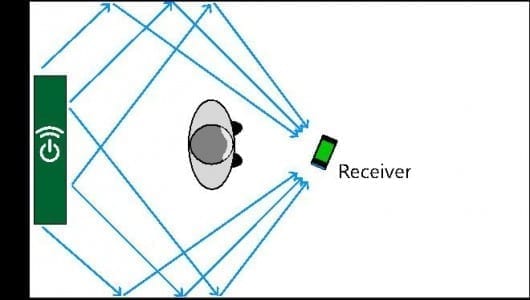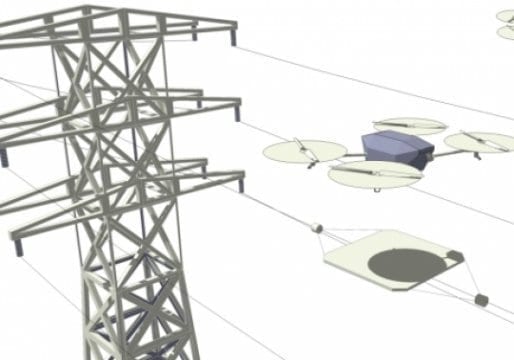
In 2008, Gartner Research released a report in which it identified the number one IT grand challenge as “Never having to manually recharge devices.”
Physicist Hatem Zeine has invented what he believes to be the answer to this challenge. The Cota wireless power transmission system uses intelligently steered phased array antennas to focus a beam of microwaves on a receiver module – and only on that module. The inherently safe technology can deliver electrical power up to 30 feet from a central transmitter without any line-of-sight requirement and without interfering with other devices. The system is projected to hit the market in 2015.
At Tech Crunch Disrupt 2013, Hatem Zeine pulled the curtain on the Ossia, Inc. development company by introducing the Cota wireless power transmission system. The Cota technology uses steered phased array microwave antennas and the time-reversal properties of electromagnetic radiation to focus several watts of power on a wireless receiver while preventing any of the radiation to hit obstacles, resulting in an inherently safe charging system.
Cota uses a single microwave transmitter, operating in the 2.4 or 5.8 GHz industrial, scientific, and medical (ISM) bands that are also used by Wi-Fi routers. Unlike most wireless charging systems we’ve seen that require the close proximity between the transmitter and the device being charged, the Ossis transmitter will provide effective charging to distances of about 30 feet (9 m). This means that a single unit would suffice for most households and offices. The microwave power from the transmitter is directed onto charging receivers that convert the received power into a form that can be used to charge device batteries, or even to directly run portable devices.
The charger is housed in an 18″ cube while the receiver resides on a chip and uses a chip antenna for operation. The commercial version of the receiver will be small enough to fit inside a phone or even a AAA battery according to Zeine. The amount of electrical power that will initially be made available by a single receiver is expected to around 1 W (about a third the power transmitted via a USB socket), which is sufficient for charging multiple portable devices. However, the use of unmodulated RF power to transfer power does not seem to fall under any specific FCC regulation in the US. As Cota is not being used for telecommunication, the power which could be made available will be controlled by the general ISM regulations, which allow much larger power than the maximum one watt of a Wi-Fi router. Worldwide, of course, the limits will depend on local regulations.
The Cota system works by a clever combination of phased-array steering antennas on the transmitter and locator beacons on the receivers. In a room without obstacles, the RF radiation from the locator beacon (pulsed at 100 times/sec) travels directly from the receiver to the walls of the room. A portion of that radiation will strike the transmitter unit, whose electrically-steerable phased-array antennas (20,000 individually controlled antennas are being planned for the first commercial system) will not only detect the radiation, but also the direction from which it is arriving. This is similar in principle to the Lytro camera, which records the complete light field of a scene, rather than just the intensity of light at a particular surface.
The Latest Bing News on:
Wireless power transmission
- Here comes the Sun - space-based solar power in the spotlighton April 26, 2024 at 2:24 am
Could 24/7 solar power from orbit be the answer to the world's future energy challenges? KATE ARKLESS GRAY reports from the International Conference on Energy from Space 2024, held at RAeS HQ, on ...
- Sprint Nextelon April 25, 2024 at 5:00 pm
The Company offers wireless and wireline voice and data transmission services to subscribers in all 50 states, Puerto Rico and the United States Virgin Islands under the Sprint corporate brand ...
- From Nuclear Shadows To Celestial Rays: Navigating The Evolution Of Power – Unravelling The Pioneering Visionson April 24, 2024 at 5:49 am
Ever imagined charging your phone just by being outdoors? Welcome to the future of wireless power, not just on Earth but extending into the vastness of space!
- Wireless Power Transmission Market CAGR of 23%, Growth Analysis, Size, Key Players, Share, Research and Forecast to 2024 to 2032on April 18, 2024 at 3:58 pm
Request To Download Free Sample of This Strategic Report @:- https://reportocean.com/industry-verticals/sample-request?report_id=bw249 ...
- Notre Dame to host event for anniversary of first wireless transmission in North Americaon April 16, 2024 at 4:18 pm
April 19 marks the 125th anniversary of the first wireless transmission in North America, which was sent from Notre Dame to Saint Mary's College in South Bend. It was sent by Professor Jerome Green, a ...
- Scientists reveal wireless power transmission for lunar communicationon April 14, 2024 at 7:02 am
How can future lunar explorers maintain constant communication with Earth from the far side of the Moon, perpetually hidden from our planet? A recent study submitted to the IEEE Transactions on ...
- Space-Based Solar Farms Getting Real After Succesful Test of Wireless Power Transmissionon April 12, 2024 at 1:05 am
It is, according to Space Solar, "the world’s first 360° wireless power transmission system." The technology is not here yet in full-size form, but the company recently put a scaled-down ...
- Wireless power transmission could enable exploration of the far side of the moonon April 10, 2024 at 5:00 pm
These contrasting conditions are ideal for the application of wireless energy transmission (laser power beaming technology), which could provide a continuous power supply in shadowed areas by ...
- Beaming solar power to Earth from space a step closer after new breakthroughon April 5, 2024 at 6:02 am
“With this demonstration of the world's first 360° wireless power transmission, we're not only advancing our own capabilities but also laying the foundation for a brighter, cleaner future for ...
- Solar power beamed to Earth from space could happen within decadeon April 4, 2024 at 11:00 pm
Space Solar, based in Belfast, has demonstrated the world’s first 360-degree wireless power transmission – an important milestone of the technology, which could bring limitless green energy.
The Latest Google Headlines on:
Wireless power transmission
[google_news title=”” keyword=”Wireless power transmission” num_posts=”10″ blurb_length=”0″ show_thumb=”left”]
The Latest Bing News on:
Wireless charging systems
- Case Study: Wireless Charging of AGVs and AMRs Increases Productivityon April 25, 2024 at 8:27 am
FFT located in central Germany, is recognised globally as one of the leading providers of systems for automated, flexible manufacturing plants. As a comprehensive turnkey partner, FFT delivers ...
- Detroit debuts 'road of the future' with wireless electric vehicle chargingon April 25, 2024 at 6:39 am
Detroit is testing a new way to charge electric vehicles that don’t require plugging in. Just park or drive your car on the right strip of road and watch the battery meter tick up.
- Will induction charging solve EV range anxiety?on April 23, 2024 at 9:04 pm
While almost all EVs have relied on wired charging solutions, in which drivers plug in a cable to recharge the car’s battery, wireless charging has the potential to make EV ownership more convenient, ...
- Android 15 to come with NFC-based wireless charging support: All you need to knowon April 22, 2024 at 6:34 am
As anticipation builds for the official unveiling of Android 15 at Google I/O 2024, the prospect of NFC-based wireless charging represents a significant leap forward in charging technology. If ...
- Android 15 Said to Support NFC Wireless Charging Feature to Add Another Option to Charge Deviceson April 22, 2024 at 3:57 am
Tinkering with the codes, Rahman also found references to features such as starting and stopping NFC charging, reading the charging payload information which is sent through NFC, and more. It is ...
- Does the iPhone 12 support faster Qi2 wireless charging? I tested it to find outon April 17, 2024 at 2:00 pm
To test whether the iPhone 12 can charge using the full speed of Qi2 wireless charging, I used the Nomad Qi2 Magnetic Charging Stand (the black one) with its included cable and a separately purchased ...
- The Next Android Update May Add a New Charging Standard to Your Phoneon April 17, 2024 at 10:30 am
Google is working on NFC wireless charging, a feature discovered in the first beta for Android 15. This standard would allow for slow charging over NFC, perfect for smaller devices.
- Project Aims to Develop Wireless Charging for EVs Moving at Highway Speedson April 17, 2024 at 7:35 am
Purdue University engineers and the Indiana Department of Transportation (INDOT) are working to make it possible for electric vehicles ranging from ...
- WiTricity joins new Japanese EV wireless charging councilon April 17, 2024 at 6:13 am
WiTricity, a company based in Massachusetts, has announced its role as one of the founding members of the Japanese EV Wireless Power Transfer Council. This newly established council also includes ...
- You’ll Soon Have A New Charging Option On Your Android Phoneon April 16, 2024 at 11:40 am
Qi wireless charging is a current standard for many smartphones and other devices, and it delivers up to 15W over a distance of 4cm. However, it requires a bigger coil inside the devices to work, ...
The Latest Google Headlines on:
Wireless charging systems
[google_news title=”” keyword=”wireless charging systems” num_posts=”10″ blurb_length=”0″ show_thumb=”left”]










